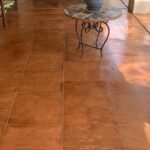Stamped concrete, also known as textured or imprinted concrete, is a decorative concrete technique used to mimic the appearance of natural materials such as brick, stone, slate, tile, and wood. It involves pressing patterns or textures into freshly poured concrete before it sets, creating a decorative surface that resembles other materials but offers the durability and affordability of concrete.
Here’s how the stamped concrete process typically works:
- Preparation: The surface where the stamped concrete will be installed is prepared by compacting the soil and adding a base material such as gravel or sand. Forms or molds are then placed around the perimeter to contain the concrete.
- Pouring: Fresh concrete is poured onto the prepared surface and spread evenly using tools such as screeds and floats.
- Stamping: While the concrete is still wet and pliable, stamping mats or texturing tools are pressed into the surface to create patterns, textures, and imprints. These mats or tools are often made from rubber or polyurethane and come in various designs to mimic different materials.
- Coloring: Integral color can be added to the concrete mix before pouring to achieve a base color. Additionally, surface colorants or stains can be applied after stamping to enhance the appearance and add depth to the texture.
- Finishing: After the concrete has set to the proper hardness, any excess release agent or colorant is washed off, and the surface is sealed to enhance its durability, protect against staining, and bring out the colors.
Stamped concrete offers several advantages:
- Versatility: It can be customized to match various styles and architectural themes.
- Cost-effectiveness: Stamped concrete is often more affordable than natural stone or pavers.
- Durability: It is resistant to wear, fading, and weathering, making it suitable for both indoor and outdoor applications.
- Low maintenance: Stamped concrete requires minimal maintenance compared to traditional paving materials. Periodic sealing and occasional cleaning are typically all that’s needed to keep it looking its best.
Stamped concrete is commonly used for driveways, patios, walkways, pool decks, and other outdoor hardscape surfaces, but it can also be used indoors for floors and countertops, providing a versatile and visually appealing alternative to traditional flooring materials.










No comment